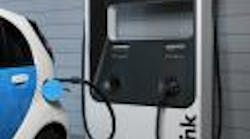“Most electric vehicle drivers will want to be able to plug in according to their own needs, but unmanaged charging on a large scale will be costly for everyone—the driver, the utility and the grid operator.” –Sam Jaffe, Research Manager at IDC Energy Insights
It’s one of those “oh but there’s THIS issue” moments when it comes to contemplating a wholesale shift to alternate transportation propulsion solutions: how to meet the fuel and/or power demand such solutions will require.
In this case, it's courtesy of a recent study concerning the re-charging demand created by electric vehicles (EVs), one that finds simply “plugging in” just one million of them could add $750 million in annual wholesale energy costs to the U.S. electrical grid – unless what’s dubbed "smart charging" is adopted.
This is from a joint study of what’s being called “ad hoc” charging conducted by the firms PJM and Better Place – “ad hoc” basically a fancy way of defining how we refuel our gasoline and diesel-powered vehicles today, which is basically at any time of the day or night we want.
Yet “refueling” significant numbers of EVs in this manner would create a huge extra load on our already overtaxed electrical grid in the U.S. Just think about what would happen today, with 15 states suffering from a massive heat wave, if folks just started plugging in their EVs when they felt like it. You’d no doubt be witnessing a lot of blown transformers and power blackouts as air conditioning demand and EV recharging overloaded the system.
[Though it’s a marketing piece, the video below from Southern California Edison (SCE) noted that “ad hoc” EV charging would really damage local distribution networks, not the big transmission grid itself.]
“Smart charging,” however, is an effort to get folks to re-charge EVs when electric power demand is at its lowest – something, however, that requires real-time coordination through a centrally dispatched grid, which will facilitate prioritization and varying charging rates.
Thus, “smart charging” one million electric cars via a central network operator can cut in half the increase in wholesale energy costs compared to simply plugging in or time-of-use pricing – while reducing driving costs by one-fifth, the study concludes.
PJM and Better Place analyzed the impact of one million electric cars on the grid supplying the Mid Atlantic States, with the greater Washington D.C.–Baltimore area was selected for modeling because it already experiences electric power transmission congestion issues and is a targeted area for EV adoption.
“Because of the ad hoc nature and unpredictability of when each electric car would be plugged in, the extra $750 million in annual costs would be borne unequally by market participants and consumers,” said Hugh McDermott, vp-utility and Smart Grid alliances for Better Place. “With smart charging, a central network operator is able to leverage dynamic wholesale energy prices to optimize the entire fleet’s charging at the lowest possible cost and impact to the grid and the consumer.”
The goal of the study was to demonstrate the value of “EV Network Operator" or what's dubbed an "Aggregator” that manages EV charging and the impact on the wholesale energy market, production costs and ancillary services, he added.
“While many of the advantages of electrification of transport are well known, such as the diversity of domestically available fuels, price stability and spare capacity, this study reveals that managed charging can optimize the relationship between EVs and the grid, minimizing capital expenses and maximizing grid reliability,” noted Robbie Diamond, president and CEO of the Electrification Coalition (EC).
It’s just one of those side effects the nation must consider as it starts to seriously explore switching to alternate forms of transportation power.



